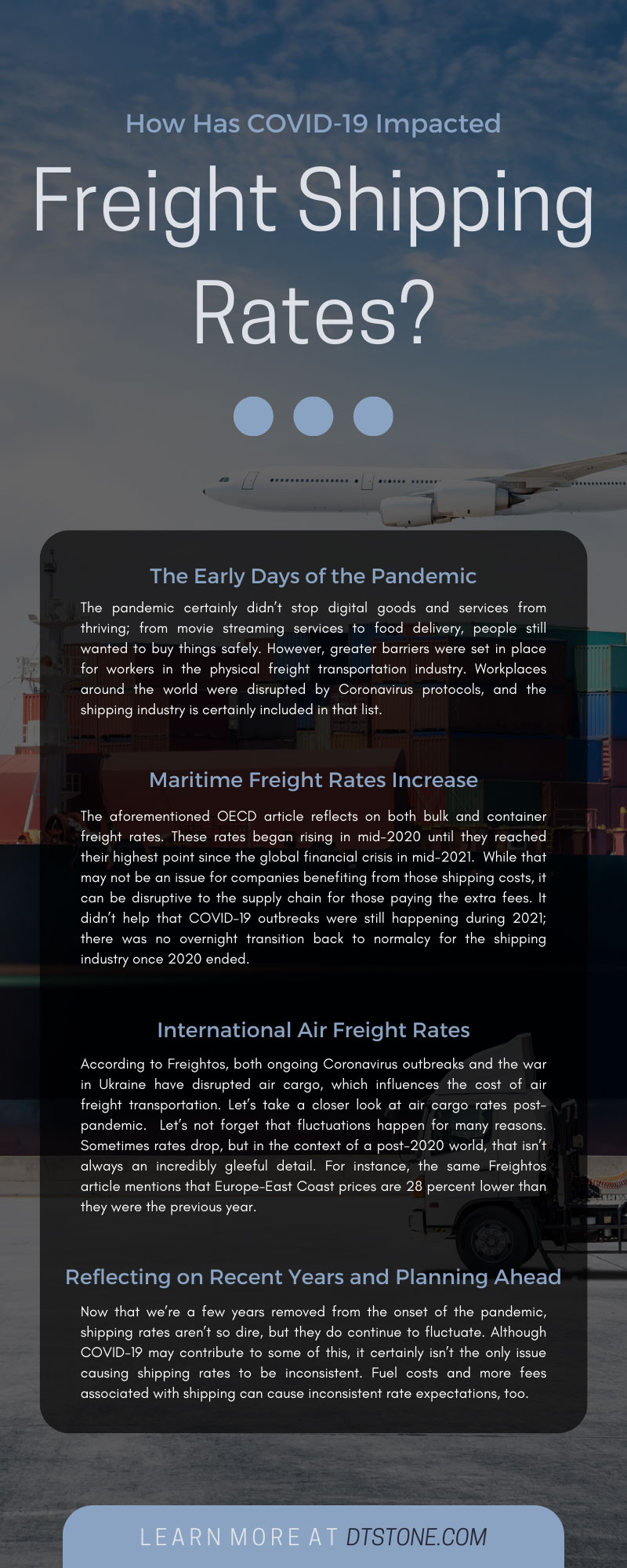
The world has changed quite a bit since the COVID-19 pandemic began in early 2020. Everyone has seen the changes in their day-to-day lives through the way they interact with people when socializing, shopping, and working. However, many companies had to deal with another disruption during COVID-19—the virus’s impact on the freight shipping industry.
Now that several years have passed since the start of the pandemic, it is a great time to reflect on what happened to international and domestic shipping during this time. Moreover, such reflection can help us learn how to maintain efficient, modern shipping strategies. For example, we can begin to analyze how COVID-19 has impacted freight shipping rates.
If you’re trying to move freight internationally or domestically, you should know how the industry has changed since 2020.
Read below to learn how the Coronavirus’s impact on the supply chain has extended further than simply delaying your neighbor’s latest Amazon delivery.
The pandemic certainly didn’t stop digital goods and services from thriving; from movie streaming services to food delivery, people still wanted to buy things safely. However, greater barriers were set in place for workers in the physical freight transportation industry. Workplaces around the world were disrupted by Coronavirus protocols, and the shipping industry is certainly included in that list.
Domestic air, road, and train travel allow freight to move efficiently. When it comes to international shipping, both air and sea are the primary modes of transportation.
This process became less efficient when global lockdowns prevented shipping services from moving cargo at their usual pace. While lockdowns occurred all over the world, demand for buying physical goods did not, so a backlog of cargo developed in the global shipping chain. Of course, some products were more in demand than others.
For example, as a recent article from the OECD mentions, personal protective equipment (PPE) was among the products in unusually high demand during the pandemic due to their necessity for safer public encounters. This shift in supply demand and transportation capabilities caused frustrating bottlenecks for freight, but the physical constraints weren’t the only barriers.
Now that you have a better understanding of COVID-19’s impact on the shipping industry, let’s take a closer look at the titular question: How has COVID-19 impacted freight shipping rates? The aforementioned OECD article reflects on both bulk and container freight rates. These rates began rising in mid-2020 until they reached their highest point since the global financial crisis in mid-2021.
While that may not be an issue for companies benefiting from those shipping costs, it can be disruptive to the supply chain for those paying the extra fees. It didn’t help that COVID-19 outbreaks were still happening during 2021; there was no overnight transition back to normalcy for the shipping industry once 2020 ended. That said, it’s important to remember that not every increase in freight shipping rates is solely due to the pandemic.
According to Freightos, both ongoing Coronavirus outbreaks and the war in Ukraine have disrupted air cargo, which influences the cost of air freight transportation. Let’s take a closer look at air cargo rates post-pandemic.
Let’s not forget that fluctuations happen for many reasons. Sometimes rates drop, but in the context of a post-2020 world, that isn’t always an incredibly gleeful detail. For instance, the same Freightos article mentions that Europe-East Coast prices are 28 percent lower than they were the previous year.
Before you start celebrating, Freightos’s article reminds us that this 28 percent rate drop still accounts for prices being 50 percent higher than average. As you can see, it’s easy to say that the pandemic caused a lot of problems around the world, but the truth of the matter is a bit more nuanced. In the current state of the post-pandemic shipping industry, costs can fluctuate, but that doesn’t mean companies can’t start building better strategies to prepare for the future.
Of course, this is only a snapshot of the shipping world as a result of the pandemic because so much has happened in recent years. We could list a flurry of graphs comparing the numbers over the years, but there’s more to explore with this topic. Simply put, the pandemic put a lot of pressure on supply chains worldwide, resulting in product demand fluctuating across the board and ultimately leading to freight bottlenecks at ports and increased shipping rates.
Now that we’re a few years removed from the onset of the pandemic, shipping rates aren’t so dire, but they do continue to fluctuate. Although COVID-19 may contribute to some of this, it certainly isn’t the only issue causing shipping rates to be inconsistent. Fuel costs and more fees associated with shipping can cause inconsistent rate expectations, too.
One additional way that COVID-19 has affected freight shipping rates occurs in the strategy side of the industry. In other words, the pandemic showed that companies must be ready to pivot when extraordinary obstacles pop up. For this reason, it’s critical to build a shipping system for your company that is as efficient during routine work as it is when dealing with unexpected problems. That’s easier said than done, so how do you do it?
A great supply chain begins with a professional, experienced team of logistics specialists. For example, at Diversified Transportation Services, we manage a company’s shipping logistics to help ensure that shipments are arranged in an efficient and reliable way. Mislabeled shipments, mishandled goods, and inefficient shipping practices can strike when you don’t have focused, trained professionals by your side.
One of the many ways we can assist with freight transportation is through international freight forwarding services. Although we are not freight forwarders, we work with them to build an appropriate shipping strategy that aligns with the specific solution that the shipment calls for.
By partnering with a 3PL to oversee your company’s freight transportation, you can focus elsewhere while having peace of mind knowing that shipping specialists are managing everything on the freight side of the project. Take a closer look at your shipping strategy today to determine if you still have room to learn from the pandemic.

Whether you're a company looking to improve one facet of your supply chain, your entire supply chain, or simply looking for a transportation and logistics consultation, we can help.